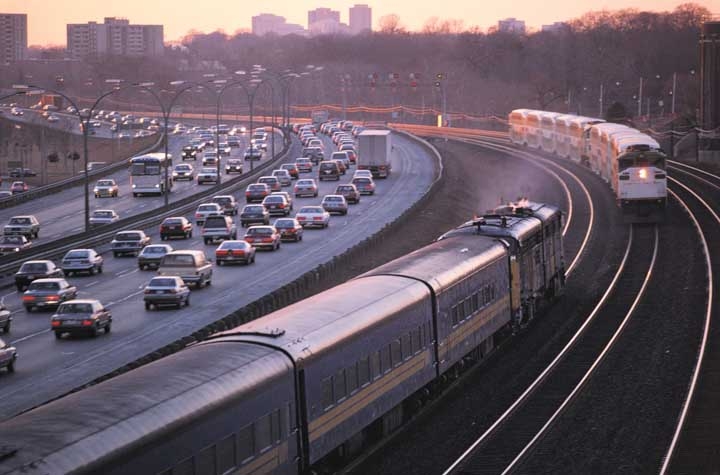
CANADIAN RAILWAYS: Assisting Canada’s Environmental Performance
Canada’s railways run an average of 1,100 passenger and goods trains every day, often over some of the world’s most rugged terrain and in some of the world’s worst weather conditions. Canada’s railways have the best safety record in North America and provide by far the safest means of ground transportation in Canada. Yet this is but one of the many achievements that make Canadian rail a great story to share.
Environmental policies in Canada, at federal and provincial levels of government, are being developed in response to public demands for improved air quality, reductions in greenhouse gas (GHG) emissions and increased energy efficiency. In response, the Canadian government issued Turning the Corner: Canada’s plan to reduce greenhouse gas emissions and air pollution in 2007. The plan provides an outline of policies and programs to improve air quality and reduce GHG emissions, including a commitment to put in place regulations on locomotive emissions. Provinces are also proceeding with their own strategies and programs to mitigate the growth in GHG emissions and improve air quality. Like other countries, Canada is faced with the challenge of reducing emissions growth in a highly competitive global economy. At the same time, Canada’s economic strength and community well-being must be assured.
And this is where the rail sector can be a key component in an environmental strategy to reduce emissions associated with transportation activity.
Railways are vital to Canada’s economy and society. They are an extension of the nation’s industry and resource base. They provide a seamless system linking the regions to national, North American and global markets through major centres, borders and trade gateways. They contribute $10 billion annually to the economy, directly employ some 35,000 people and handle 75 per cent of the nation’s surface freight on a tonne-kilometer basis.
Canada’s freight railways are in a continual process of investing, modernizing and adapting to meet and support market demands and improve the efficiency of their operations. Major advances in locomotive technology, infrastructure and communications systems have been introduced and widely implemented across the industry. System-wide, continuing improvements in operations have been undertaken to optimize capacity and fluidity. These include areas such as formal track-sharing arrangements between railways, expanded or new terminals, and efficient intermodal/container and bulk movements. In addition, since the mid-1990s, many short- line railways have been formed across Canada to maintain the links between the regions, mainlines and the global economy.
The rail passenger sector, now carrying 72 million passengers annually, has been responding and adapting to the market and consumer needs. The sector is investing in the modernization of rolling stock, expanding its facilities and providing increasingly attractive travel options for urban commuters within high- density population corridors, as well as increasing demand for intercity travel.
Canada’s freight railways pay their own way; they finance, build, operate, police and pay property tax on their right-of-ways. In 2010, Canada’s railways invested more than $1.75 billion in their infrastructure and rolling stock. When it is considered that Canada’s transportation infra- structure deficit may be as high as $100 billion, the railways’ independent ability to efficiently serve Canadian industry and travelers becomes of very high value. Despite vast distances, rugged topography and climate extremes, Canada’s railways are among the most efficient and well-managed in the world.
Importantly, Canada’s railways are also making major environmental contributions. Through separate, small footprint rights-of-way, they provide a major capacity and mobility alternative to roads in crowded corridors and in urban areas. They use only one-third of the land for capacity equivalent to roads. In addition, one train can move one tonne of freight 180 kilometres on a single litre of fuel. In all, railways relieve congestion pressure on roads, provide environmentally attractive options, and improve transportation safety.
The rail industry is ready to move forward and is attuned to the Canadian environmental imperative. With its fuel and emissions efficiency, its small footprint and its ability to move on rights-of-way separate from congested highways, rail has a unique environmental effectiveness.
For the Canadian transportation system, the growth in GHG emissions is no longer sustainable. Canada must encourage and enable an effective and sustainable transportation system to serve the nation and its regions.
A system that enhances movement of freight and passengers, and continually strengthens Canada’s international competitiveness, is critical to our nation’s economic well-being.
In the face of growing international trade competition and declining economic growth, Canada must assure reliable, seamless capacity and “reach” for shippers nationally, in North American markets, and internationally. Any Canadian solution must recognize the need to better harmonize our transportation regulations and policies with those of the United States – to assure unhindered, fluid movement of our goods and our country’s future competitiveness.
While transportation as a whole is facing major challenges, rail has achieved tremendous improvements in fuel efficiency that have enhanced its environmental performance. For example, the 1995-2005 Memorandum of Understanding (MOU) between the Railway Association of Canada and Environment Canada demonstrated the great value of a voluntary, soundly- based agreement between industry and government. The MOU allowed the railways to manage their fleet and operations to meet their operational and customers’ needs while sharply reducing workload emissions.
This voluntary approach has proven to be very successful. In the period of the MOU, freight rail revenue tonne- kilometres increased by 22.5 per cent, but aggregate fuel consumption was hardly affected as railways met the challenge and brought into service new equipment and operating practices. Further, emissions from rail operations of smog-forming oxides of nitrogen have averaged below 115 kilotonnes, despite the unprecedented traffic growth over this time period. Passenger railways realized similar improvements in emissions reductions on a passenger-km basis. The current Environmental Performance Agreement between the railways, Environment Canada and Transport Canada for 2006-2010 built upon the success of the 1995- 2005 MOU. It recognizes more fuel-efficiency initiatives and also encourages partnerships among all railways to use research, development and assessments of other emissions- reduction strategies.
The program includes agreed perfor- mance objectives to reduce GHG and criteria air containments emissions, reporting accountability on locomo- tive emissions, consistent monitor- ing, a publicly available annual report, a progressive schedule of fleet mod- ernization, and targeted continuous improvement in workload emissions, recognizing U.S. Environmental Protection Agency standards. It also requires the rail industry to develop and submit a GHG Reduction Action Plan to the federal government within six months of signing the MOU. The rail industry was the first industry in Canada to formally submit a GHG Reduction Action Plan to the federal government.
The benefits of such an agreement and process are:
• Targeted workload emissions, with annual reporting; is simple to administer.
• Timely implementation for government with no regulatory overhead.
• Voluntary/flexible options as a means to achieve reduced emissions.
• New initiatives and operating practices.
• A multi–year industry commitment to the desired environmental result.
• Multi–stakeholder research and development.
Canada’s rail industry has made a significant contribution to environ– mental sustainability in the past and it is well positioned to play an important role in the future. The sector is ready to work with governments, communities and other private sector partners to do its part in finding a sustainable future for Canadians. The industry’s members have proposed a number of initiatives which they believe will make a significant, cost- effective contribution. At the same time, the country’s railways will continue to assist Canadians with ongoing efforts to ensure the nation’s social and economic well-being.

Greenhouse Gas Emissions
• Transportation accounts for 18 per cent of Canada’s GHG emissions — at 190,000 kilotonnes per year, one of the highest emissions levels for transport per capita in the world.
• 87 per cent of transportation GHG emissions are attributed to road transportation.
• Only 3 per cent of transportation GHG emissions are attributed to freight and passenger rail.
• If 20 per cent of current truck freight were shifted to rail, Canada would realize a reduction of 5.75 million tonnes, of GHG emissions annually.
Energy Efficiency
• Canada has some of the highest levels of road freight usage/intensity per capita in the world. It uses 23 billion litres of diesel fuel annually.
• Rail moves more freight on a tonne–km basis than road, yet uses only 1.76 billion litres of diesel annually.















